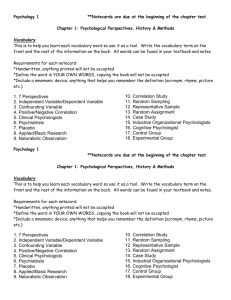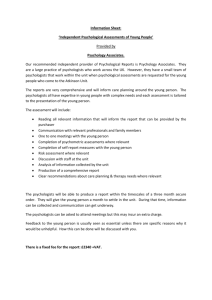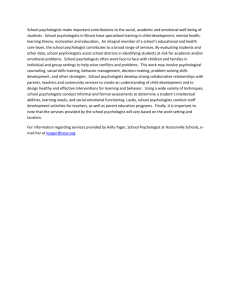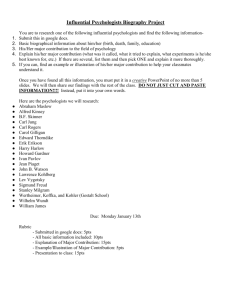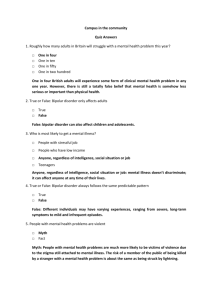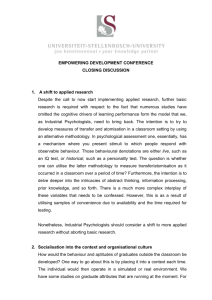American Psychological Association 5th Edition
advertisement
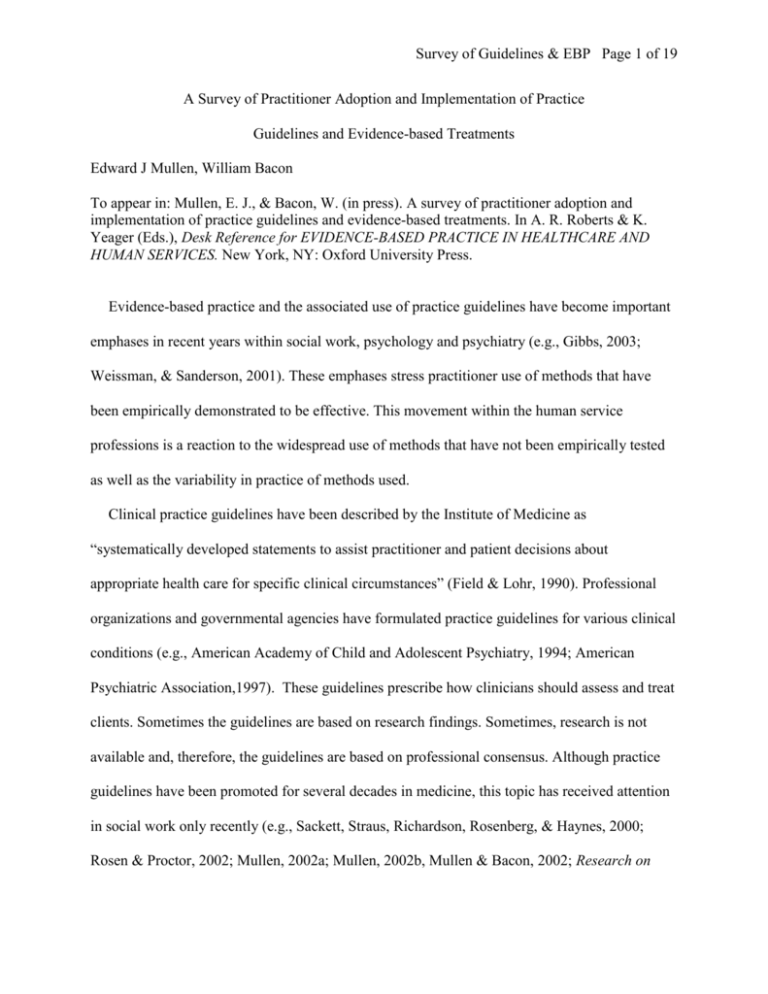
Survey of Guidelines & EBP Page 1 of 19 A Survey of Practitioner Adoption and Implementation of Practice Guidelines and Evidence-based Treatments Edward J Mullen, William Bacon To appear in: Mullen, E. J., & Bacon, W. (in press). A survey of practitioner adoption and implementation of practice guidelines and evidence-based treatments. In A. R. Roberts & K. Yeager (Eds.), Desk Reference for EVIDENCE-BASED PRACTICE IN HEALTHCARE AND HUMAN SERVICES. New York, NY: Oxford University Press. Evidence-based practice and the associated use of practice guidelines have become important emphases in recent years within social work, psychology and psychiatry (e.g., Gibbs, 2003; Weissman, & Sanderson, 2001). These emphases stress practitioner use of methods that have been empirically demonstrated to be effective. This movement within the human service professions is a reaction to the widespread use of methods that have not been empirically tested as well as the variability in practice of methods used. Clinical practice guidelines have been described by the Institute of Medicine as “systematically developed statements to assist practitioner and patient decisions about appropriate health care for specific clinical circumstances” (Field & Lohr, 1990). Professional organizations and governmental agencies have formulated practice guidelines for various clinical conditions (e.g., American Academy of Child and Adolescent Psychiatry, 1994; American Psychiatric Association,1997). These guidelines prescribe how clinicians should assess and treat clients. Sometimes the guidelines are based on research findings. Sometimes, research is not available and, therefore, the guidelines are based on professional consensus. Although practice guidelines have been promoted for several decades in medicine, this topic has received attention in social work only recently (e.g., Sackett, Straus, Richardson, Rosenberg, & Haynes, 2000; Rosen & Proctor, 2002; Mullen, 2002a; Mullen, 2002b, Mullen & Bacon, 2002; Research on Survey of Guidelines & EBP Page 2 of 19 Social Work Practice, 1999). Not examined is the question of how agencies and practitioners view this development. Prior research has indicated that practitioners are not likely to use research in practice (Kirk, Osmalov & Fischer,1976; Kirk & Reid, 2002, chap 8). Little is known about the use of guidelines in social work practice and how social worker practitioners view the use of guidelines (Sanderson, 2002). Accordingly, this article presents findings of one of the few studies examining practitioner attitudes toward and use of practice guidelines and other aspects of evidence-based practice. We conducted a survey examining practitioner awareness of practice guidelines, specification of guidelines known about and used by individual practitioners; practitioner attitudes toward the use of guidelines, and their preferences for guidelines based on expert consensus and/or based on empirical research findings. In addition, the survey examined a variety of aspects of research use for practice. The survey was conducted in a large, urban, non-profit social agency. Method The agency surveyed is among the largest of its type in the United States. It is noted for the high quality of its services and training programs. Masters level social workers are the primary providers of service although the staff is multidisciplinary including psychologists, psychiatrists and other mental health professionals. At the time of the survey, the agency employed a professional staff of 697. Of this number, 500 were engaged in provision of clinical services including 42 psychiatrists, 53 psychologists, 386 social workers, and 19 other mental health professionals. This was the population surveyed. The organization provided a list of all professional staff employed by the agency at the time of the survey, August 1999. A questionnaire was sent by the organization to each staff member addressed to his or her home. A cover letter was sent from the agency executive director stressing the importance of the survey Survey of Guidelines & EBP Page 3 of 19 and asking for cooperation. The cover letter explained that the study was seeking information regarding clinical practice and that it was being conducted by a university-based social work research center. Respondents were asked not to write their names on the questionnaire. They were assured that their questionnaires and responses would be anonymous. The questionnaires were to be returned to the research center. Questions were to be directed to the center rather than to the employing organization. Because of the assurance of anonymity and methods employed we assume that practitioners provided honest answers. Sample Characteristics Of the 500 questionnaires mailed to the practitioners’ homes, 124 usable ones were returned (24.8%). Of these 124 respondents, 65.3% (81) were social workers, 12.9% (16) were psychologists, 13.7% (17) were psychiatrists and 8.1% (10) were other mental health professionals (e.g., art therapists). Relative to the population distribution social workers were somewhat less likely to have responded to the survey (21%, 81 of 386) than the other professions (38%, 43 of 114). With an overall return rate of approximately 25%, one cannot be confident that the respondents are representative of the total population of clinicians at the agency. It is reasonable to suppose that on average respondents were more favorably disposed to research than their non-responding colleagues. One might also assume that respondents were less likely to be those who felt overburdened by paperwork and administrative demands. The number of respondents who were psychologists or psychiatrists was especially small so that conclusions pertaining to those professions must be made with caution. Because the 10 respondents classified as “other mental health professionals” are from a range of professions it is not possible to treat them as a homogeneous professional group. Accordingly, they are excluded in the following analyses so that subsequently, we report on a total set of 114 respondents. While no claim of Survey of Guidelines & EBP Page 4 of 19 representativeness can be made, the findings do provide initial information regarding an important and un-researched area of pertinence to practice. Nevertheless, the low response rate must be recognized as a serious limitation so that generalizations from this sample to professional groups can only be made with extreme caution. Nearly three-fourths (71.9%, n=82) of the respondents reported their highest academic degree to be a masters degree, 14.9% (n=17) to be an M.D., and 13.2% (n=15) to be a Ph.D. or its equivalent (13.2%, n=15). All social workers and one psychologist held the master’s degree as the highest degree. The large majority of respondents were employed in an outpatient clinic (1.6%, n=69) or a residential facility (23.2%, n=26). Other reported locations were scattered site facility (3.6%, n=4), day treatment program (5.4%, n=6), school-based program (1.8%, n=2), and other type of facility (4.5%, n=5). Nearly all the respondents (95.6%, n=109) were engaged in direct practice and some were also engaged in clinical supervision, clinical training, and administration of clinical services. Most of the respondents reported full-time employment (63.2%, n=72). The length of time employed by this agency ranged from two months to 40 years. The median was three years whereas the mode was one year. Approximately 28% (28.6%, n=15) of the respondents had worked for the organization one year or less whereas 25% (n=36) had worked at the organization for six or more years. The number of years since licensure or certification ranged from one to 49 years. The median was seven years whereas the modes were one and two years. About a quarter (24.6%) of the respondents had received licensure or certification within the past two years whereas 26.4% had received licensure or certification 16 or more years earlier. Survey of Guidelines & EBP Page 5 of 19 About Practice Guidelines We asked about the practitioners’ knowledge of and attitudes toward practice guidelines. As an introduction to these questions we provided a brief description of what we meant by practice guidelines. Because we found that there were systematic differences among the professions, the findings are presented by profession. Heard About Practice Guidelines We asked the respondents if they had ever heard of practice guidelines before this survey. Nearly all of the psychiatrists (94.1%) had heard about practice guidelines and the overwhelming majority of psychologists (81.3%) had also heard about guidelines, but less than half of the social workers had heard of them (42.3%). Know of a Particular Guideline When asked if they were aware of a particular guideline, most psychiatrists said they were aware of at least one (87.5%), but relatively few psychologists (12.5%) or social workers (18.4%) reported awareness of even one guideline. For those who said that they were aware of a guideline we asked them to specify the organization that had developed the guideline and/or what disorder or situation it addressed. Fourteen of the 17 psychiatrists said they knew of a particular guideline and 12 of these listed the American Psychiatric Association and the American Academy of Child and Adolescent Psychiatry. Just two of the 16 psychologists reported knowing a guideline, and no psychologist actually listed an organization. Only 14 of the 81 social workers reported knowing a particular guideline, and just three of these listed organizations. Twelve of the 17 psychiatrists responded that they were aware of guidelines pertaining to a range of mental disorders including schizophrenia, substance abuse, eating disorders, bipolar Survey of Guidelines & EBP Page 6 of 19 disorder, major depression, dementia, anxiety disorders, panic disorder, and borderline personality disorders. Eight of 81 social workers listed disorder-specific or situation-specific guidelines. These were guidelines pertaining to child abuse and neglect reporting, suicide intervention, depression therapy, trauma assessment, PTSD, how to treat and transfer juvenile sex offenders, teenagers in residential care with conduct disorders, borderline personality disorder, and treatment of depression in residential treatment centers. One of the 16 psychologists indicated awareness of a guideline pertaining to depression evaluation for medication. Used Guideline Respondents were asked if they had ever used any practice guideline to help plan treatment. The majority of psychiatrists (64.3%) said they had, only one psychologist (6.3%) had, and about one in five social workers (18.7%) had used a guideline. For those who said they had used a guideline, we asked what the guideline was and what their experience had been with the guideline’s use. For those who said they had not used a guideline, we asked why they had not used one. Most of the social workers who had used a guideline reported vague comments about why a guideline had been used. Only three of the comments could be classified as indicating that the guideline was considered to have been useful to improve treatment. Two indicated that the reason for use was that the guideline was required. One psychologist who had used a guideline commented “I followed a guideline and have found it helpful.” Three guideline-using psychiatrists provided vague or neutral comments and one commented that it improved treatment (“I have used the dementia guidelines to look for treatment options for family members with a particular client”). Survey of Guidelines & EBP Page 7 of 19 Among social workers who had not used a practice guideline, the majority of the comments related to being unaware of the existence of guidelines. Some social workers provided vague or neutral comments. Two expressed a lack of need for guidelines (“I have followed the guidance of supervisors & colleagues who have extensive knowledge working with clients experiencing depression”; “agency administrative guidelines from beginning contact with a client to discharge have been clear - changed and/or modified in time and work well”). One said guidelines were not relevant (“sometimes it seems like guidelines don't incorporate culturally relevant issues + what to do”). No social worker volunteered a strongly negative opinion of guidelines’ potential usefulness, a sentiment expressed frequently by psychologists (“I don't like following a formula if it doesn't feel right for the patient”; “I am mistrustful of guidelines that seem to encourage cost-saving procedures, or exclude patient/clinician from decision”; “I'm very much a believer in the complexity of development, individual difference, and the fact that the same symptom/syndrome meant very different things in different people-- and thus required different intervention”). Among other psychologists’ responses, some pertained to guideline irrelevance (“didn't feel that such guidelines were relevant to the cases I was treating”; “didn't apply to the population working with”). Only one psychologist mentioned not being aware of guidelines and three provided vague or neutral comments as to lack of use. Four psychiatrists commented on reasons for not using guidelines (“I have read the guidelines but don’t necessarily look them up for each and every case”; “haven't had enough time or opportunities to use yet”; “Already had information”; “not needed.” Inclination to Use Guidelines We asked whether or not respondents were inclined to use guidelines, whether or not they had used them in the past. Most psychiatrists (86.7%) and social workers (81.4%) were inclined to Survey of Guidelines & EBP Page 8 of 19 use guidelines whereas about half of the psychologists were so inclined (54.5%). When asked to say why they were or were not inclined to use guidelines several reasons were common. For social workers who were inclined to use guidelines, the most common type of response (10 out of 24 responses) related to guidance. These respondents indicated that they thought guidelines would help them in conceptualizing or planning treatment. Two others specifically mentioned that guidelines would increase knowledge or skills. Four said that guidelines would improve treatment. Four social workers mentioned or implied that they were attracted to practice guidelines because of their research basis. The remaining comments made reference to willingness to use guidelines if they were not burdensome and if they were easily accessible. Four psychologists commented on why they would be inclined to use guidelines. They referred to guidance (“if clear and helpful”); their research base (“I'm interested in effective techniques based on empirical data”); and, other qualifications (“contingent on the care and guideline restrictions”; “I nevertheless reserve the right to use my clinical judgment in specific cases”). Six psychiatrists commented on why they would use guidelines, mostly making reference to their value in providing guidance (“for reference and guidance”; “They are helpful in approach to patient case”; “standardized consensus”; “as a guide to my own thinking”; “useful in client planned treatment”; “Only because they comply with my practice”). Among social workers who were not inclined to use practice guidelines, explanatory comments were usually rather vague rather than expressing concern about the validity of practice guidelines. On the other hand, psychiatrists and psychologists were more likely to describe a specific objection to practice guidelines. Survey of Guidelines & EBP Page 9 of 19 Guideline Preference Respondents were asked which type of guideline they would be more inclined to use, those based on research findings or those based on professional consensus (whether or not research supported the consensus). A number of the respondents selected both answers choices (43.8% of psychiatrists, 13.4% of social workers, and 7.1% of psychologists). Of those who selected only one choice, psychiatrists most often said they would be most inclined to use those supported by research (50% for research-only vs. 6.3% for consensus-only) whereas both social workers and psychologists said they would be most inclined to use those based on professional consensus (social workers: 50.7% for consensus-only vs. 35.8% for research-only; and for psychologists 50.0% for consensus-only vs. 42.9% for research-only). Practice Conforms to Guidelines We asked respondents if they thought their current practice conformed to what existing guidelines prescribe. All of the psychologists and most psychiatrists (85.7%) responded affirmatively, whereas about three-fourths of social workers (74.1%) thought this. When asked for their reasons why they thought that their practice did or did not conform a range of answers were given. Those who thought their practice did not conform mentioned that the guidelines probably were not promulgated by other social workers, that guidelines probably emphasized short-term treatments, or that practice guidelines are not generally consulted for treatment planning. For those who believed that their practice probably did conform to practice guidelines, most made general statements about their professional competence or the apparent effectiveness of their work. Survey of Guidelines & EBP Page 10 of 19 Other Indicators of Evidence-based Practice We asked about other indicators of an evidence-based approach to practice, including: frequency of reading professional publications, especially research publications; use of singlesubject designs; use of assessment instruments in practice; and seeking consultation from the literature, supervisors and colleagues regarding research evidence for practice decisions. Reading or Referring to Journal Articles We asked how often respondents read or referred to journal articles in their field. The modal responses were strikingly different across professions: one or two times a month for social workers; about once a week for psychologists; and a few times a week for psychiatrists. The response distribution is shown in Table 1 under the columns labeled “Articles”. Reading other Professional Literature We also asked how often they read professional literature other than journal articles (e.g., books, newsletters, etc.). These responses are shown in Table 1 under the columns labeled “Other”.1 Nearly one-quarter of social workers replied that they did this less than 1 or 2 times a month (24.6%) with 9.8% reporting doing this once or twice a year or less. About half (51.8%) reported reading or referring to other professional literature at least weekly. No psychiatrist reported such low frequency with nearly half saying they did this daily or a few times a week (47.0%). Nearly three-quarters (70.5%) reported reading or referring to other professional literature at least weekly. Psychologists reported a pattern somewhere in between, with somewhat more than one-half (56.3%) responding about once a week or 1-2 times a month; and, over one-third (37.5%) responding at least weekly. 1 Missing information is excluded from the tabulated results in tables 1 and 2, accounting for variation in the sample sizes shown. Survey of Guidelines & EBP Page 11 of 19 Table 1 Reading or Referring to Publications Frequency Social Workers Psychologists Psychiatrists Articles Other Articles Other Articles Other N % N % N % N % N % N % Daily or Nearly So 5 6.3 7 8.6 0 0.0 0 0 3 17.6 3 17.6 A Few Times a Week 11 13.8 17 21.0 3 18.8 4 25.0 7 41.2 5 29.4 About Once a Week 14 17.5 18 22.2 6 37.5 2 12.5 3 17.6 4 23.5 Once or Twice a Month 26 32.5 19 23.5 5 31.3 7 43.8 4 23.5 4 23.5 Several Times a Year 13 16.3 12 14.8 1 6.3 3 18.8 0 0.0 1 5.9 Once or Twice a Year 7 8.8 4 4.9 1 6.3 0 0.0 0 0.0 0 0.0 Less than Once a Year 4 5.0 4 4.9 0 0.0 0 0.0 0 0.0 0 0.0 Reading or Referring to Research Journal Articles We asked what types of articles respondents read. Listed were case studies, clinical theory, research articles on populations or clinical problems, research articles on clinical assessment or interventions, and research articles on outcomes or effectiveness of particular therapeutic techniques. We report on their responses about research articles only, combining the three types of research articles into a single measure. Accordingly, if a respondent said they read all three types of research articles they would receive a score of 3, if two types a score of 2, if one type a score of 1, and, if none a score of 0. As shown in Table 2 the modal responses were: “3” for psychiatrists; “1” for psychologists; and, bi-modal for social workers with approximately 29% Survey of Guidelines & EBP Page 12 of 19 reporting “0” and 29% reporting “3”. There was considerable variation among social workers whereas the other professionals tended to be less varied in their responses. Table 2 Reading or Referring to Research Journal Articles Number of Types Read Social Workers Psychologists Psychiatrists N % N % N % 0 (none) 23 29.1 3 18.8 3 17.6 1 (reads 1 type) 17 21.5 1 6.3 7 41.2 2 (reads 2 types) 16 20.3 4 25.0 3 17.6 3 (reads 3 types) 23 29.1 8 50.0 4 23.5 Using Research Literature for Practice Decisions We asked if the practitioners ever consulted the research literature when they needed to make a decision about how to proceed in treating a particular case. Most of the psychiatrists (94.1%) and psychologists (87.5%) said they did but only 64.6% of the social workers said this. For those who said they did consult the research literature we asked how often this was done. The modal response for all professionals was “several times a year” (32% of social workers; 50% of psychiatrists; and, 42.9% of psychologists). Of those social workers who responded that they did consult the research literature, 24.5% said they did this at least weekly whereas only 14.3% of the psychiatrists consulted this frequently and none of the psychologists reported this frequency. Using Research Methods in Practice We asked about the practitioners’ use of single-subject designs and assessment instruments in their own practice during the preceding two years. No psychologist reported conducting a single- Survey of Guidelines & EBP Page 13 of 19 subject design study and only about one in 10 of the social workers (11.3%) and psychiatrists (11.8%) reported doing so. Of those saying they had conducted such studies the number of studies conducted during the two-year period was almost always one. Practitioners were asked if they had used the results from any standardized assessment instrument to help them assess a client’s symptoms or response to treatment. Psychologists almost always responded that they had (87.5%), nearly three-fourths of the psychiatrists said they had (70.6%) whereas somewhat less than a third of the social workers said they had (30.4%). Of those who said they had, we asked if they themselves had administered any of these instruments. Nearly all of the psychologists (90.9%) and psychiatrists (100%) said they had whereas only a little over half of the social workers said they did (58.3%). Of those who said they had used standardized assessment instrument results we asked them to name those they had used most often. Social workers and psychiatrists most frequently cited simple symptom checklists such as the Beck Depression Inventory. Multi-symptom instruments such as the Achenbach were also relatively common. Psychologists were much more likely to employ personality tests such as the Rorschach, along with cognitive and achievement tests. Reasons for Changing Practice We asked practitioners if research findings of favorable or unfavorable outcomes with a certain technique ever caused them to change their practice, such as starting or stopping to use a particular treatment technique with some or all of their clients. We also asked if such changes had ever been brought about by their own experience of what works and what doesn’t work, and, by demands of administration or the mental healthcare marketplace. If they said any of these three had caused a change we asked them to specify what the change was and when the most recent change had occurred. Survey of Guidelines & EBP Page 14 of 19 Almost all psychiatrists said that research findings had changed their practice (93.8% or 15 of 16), whereas 42.9% of psychologists (6 of 14) and 40.6% of social workers (26 of 64) said this. In contrast, demands of administration or of the mental healthcare marketplace were said to have changed practice for approximately three-quarters of social workers (76.8%) and psychologists (73.3%) but for only about half of the psychiatrists (56.3%). Nearly all reported that their own experiences had changed their practice (87.1% of social workers, 93.8% of psychologists, and 94.1% of psychiatrists). Regarding what aspect of their practices had been changed by research findings, all the psychiatrists who answered the question (n=6) mentioned medications. Social workers and psychologists gave a much wider variety of answers, most mentioning particular techniques or treatment modalities that they had begun to use, such as behavioral techniques for learning disabilities or eating disorders, cognitive techniques for anger management, or eye movement desensitization and reprocessing for trauma. Using Supervisors and Colleagues for Practice Decisions As noted above, we had asked if the practitioners ever consulted the research literature when they needed to make a decision about how to proceed in treating a particular case. We also asked if, when needing to make a decision about how to proceed in treating a particular case, they ever consulted with a supervisor or colleague. Respondents were then asked to estimate the degree to which their consultations were directed at the consultant’s knowledge of research findings, knowledge of clinical theory, clinical wisdom or experience, or knowledge of administrative requirements. With the exception of a few psychiatrists, all respondents reported using consultation. Most social workers (80.6%) said they sought consultation a few times a week (32.5%), weekly (24.7%) or one or two times a month (23.4%). By contrast, the majority of Survey of Guidelines & EBP Page 15 of 19 psychiatrists said they did so only several times a year (57.1%) and none reported more often than once a week. Psychologists’ modal response was one or two times a month. Consultation was sought at least weekly by 70.1% of social workers, 50% of psychologists and 21.4% of psychiatrists. One-third of the respondents (41 of 124) said they sought the consultant’s knowledge of research findings. The distribution differed little among the professions. Sixty-nine percent of the respondents said they sought the consultant’s knowledge of clinical theory (85 of 124). This was true for approximately three-quarters of social workers and psychologists but only 41% of the psychiatrists. Seeking consultation regarding administrative requirements was common for all professionals (67.9% of social workers, 50.0% of psychologists, 41.2% of psychiatrists). With few exceptions respondents also sought the consultant’s clinical wisdom and experience. Implications These findings have implications for developing and using practice guidelines and evidencebased practice in social work. Viewed from the perspective of how practitioners working in organizations such as the one surveyed in this study view practice guidelines and other aspects of evidence-based practice, we draw a number of conclusions. The three mental health professions represented in this survey were strikingly different in their knowledge of practice guidelines. Psychiatrists appeared to be relatively well informed about relevant practice guidelines whereas social workers were poorly informed, typically not even aware of the meaning of practice guidelines. Psychologists were somewhere in between. Once told what practice guidelines were, social workers were inclined to be open to their use. Social workers generally were not using research findings or research methods in their practice. Psychiatrists and to a lesser extent psychologists were using findings and methods of Survey of Guidelines & EBP Page 16 of 19 assessment. Many social workers did not read the research literature often or even other professional literature. Psychiatrists read this literature frequently. Social workers were heavy users of consultation, much more so than the other professionals who functioned more autonomously. Social workers frequently sought guidance and direction from supervisors and other consultants who were viewed as repositories of knowledge based on experience and spokespersons for organizational policy. Given the low use of research methods and infrequent reading of professional literature, it is not likely that social work practitioners will be influenced significantly through these routes. Rather, supervisors and consultants seem to be the most promising conduit for knowledge regarding practice guidelines and other forms of evidence-based practice for social workers. Social workers appeared to be open to guidelines so long as they are perceived as helping to improve practice, but their preference was for guidelines that represent professional consensus rather than research evidence. A few social work practitioners deviated from this norm, appearing to function more autonomously through behaviors more like those of the psychiatrists in the sample. These social workers expressed preference for evidence-based guidelines and they have higher frequencies of reading research articles and professional publications. It is likely that they use supervisors and consultants differently as well. These types of social workers may be important resources for dissemination of evidence-based practice knowledge within social work organizations. It is likely that their training has provided them with research skills of relevance to practice. The reported findings have implications for technologies needed to assist practitioners in identification and use of evidence-based practice guidelines; for quality control and accountability; and, for education. Future work is needed to develop and test technologies that Survey of Guidelines & EBP Page 17 of 19 can facilitate the use of evidence-based practice. Because of the crucial role played by social work supervisors regarding information, dissemination research is needed to further understand how this resource can be better used to advance evidence-based practice in social work. Also, research is needed to better understand the characteristics of those social workers who are high users of research as well as how these types of social workers might be used as agents of research dissemination in social work organizations. Finally, because the study reported here is limited to one agency, studies are needed examining additional practitioners in a wide range of settings to determine how representative our findings are of the larger group of human service practitioners and to identify characteristics of situations wherein evidence-based practice and empirically-based practice guidelines have been adopted. References American Academy of Child and Adolescent Psychiatry (1994). Practice parameters for the assessment and treatment of children and adolescents with schizophrenia. Journal of the American Academy of Child and Adolescent Psychiatry, 33, 616-635. American Psychiatric Association. (1993). Practice guideline for major depressive disorder in adults. American Journal of Psychiatry, 150(4, suppl.), 1-29. American Psychiatric Association. (1994). Practice guideline for treatment of patients with bipolar disorder. American Journal of Psychiatry, 151(12), 1-36. American Psychiatric Association. (1997). Practice guideline for the treatment of patients with schizophrenia. American Journal of Psychiatry, 154(12), 1-63. Field, M. J., & Lohr, K. N. (Eds.). (1990). Clinical Practice Guidelines: Directions of a New Program. Washington, DC: National Academy Press. Survey of Guidelines & EBP Page 18 of 19 Gibbs, L. E. (2003). Evidence-based practice for the helping professions: A practical guide with integrated multimedia. Paific Grove, CA: Brooks/Cole-Thompson Learning. Kirk, S. A., Osmalov, M., & Fischer, J. (1976). Social workers' involvement in research. Social Work, 21, 121-124. Kirk, S. A., & Reid, W. J. (2002). Science and social work: A critical appraisal. New York: Columbia University Press. Mullen, E. J. (2002a). Evidence-based Knowledge: Designs for Enhancing Practitioner Use of Research Findings. Paper presented at the 4th International Conference on Evaluation for Practice, University of Tampere,Tampere, Finland. Mullen, E. J. (2002b). Evidence-based Social Work - Theory & Practice: Historical and Reflective Perspective. Paper presented at the 4th International Conference on Evaluation for Practice, University of Tampere, Tampere, Finland. Mullen, E. J., & Bacon, W. F. (2002). Practitioner adoption and implementation of evidencebased effective treatments and issues of quality control. In A. Rosen & E. K. Proctor (Eds.), Developing practice guidelines for social work interventions: Issues, methods, and a research agenda. New York City: Columbia University Press. Research on Social Work Practice. (1999). 9(3) (multiple articles on social work practice guidelines). Rosen, A., & Proctor, E. (Eds.). (2002). Developing practice guidelines for social work interventions: Issues, methods, and a research agenda. New York: Columbia University Press. Survey of Guidelines & EBP Page 19 of 19 Sackett, D. L., Straus, S. E., Richardson, W. S., Rosenberg, W., & Haynes, R. B. (2000). Evidence-based medicine: How to practice and teach EBM (2 ed.). New York: Churchill Livingstone. Sanderson, W. C. (2002). Are evidence-based psychological interventions practiced by clinicians in the field? Medscape mental health: a Medscape eMed Journal, 7(1). Steketee, G. (1999). Yes, but cautiously. Research on Social Work Practice, 9, 343-346. Weissman, M. M., & Sanderson, W. C. (2001). Promises and problems in modern psychotherapy: the need for increased training in evidence based treatments. Unpublished manuscript, Toronto, Canada.
